|
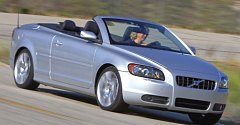 Exactly
10 years ago, Volvo introduced its first real coupe for 30 years, C70.
The C70 was developed by TWR based on Volvo 850 / S70 saloon. It looked
quite handsome and, in turbocharged T5 form, ran quite fast. However,
what made it unique was a cabin truly capable of sitting 4 adults. Two
forms were available - coupe and convertible. Both of them were
produced at the Uddevalla plant in Sweden which was a 50-50
joint-venture between TWR and Volvo. Throughout the years, the sales
was quite good and enduring. When TWR was struck by financial problem
in 2000 (which eventually led to its death), Volvo not only did not
give up the car, but acquired the remaining share of the plant. When
C70 ceased production in early 2005, over 70,000 cars had been
produced. Exactly
10 years ago, Volvo introduced its first real coupe for 30 years, C70.
The C70 was developed by TWR based on Volvo 850 / S70 saloon. It looked
quite handsome and, in turbocharged T5 form, ran quite fast. However,
what made it unique was a cabin truly capable of sitting 4 adults. Two
forms were available - coupe and convertible. Both of them were
produced at the Uddevalla plant in Sweden which was a 50-50
joint-venture between TWR and Volvo. Throughout the years, the sales
was quite good and enduring. When TWR was struck by financial problem
in 2000 (which eventually led to its death), Volvo not only did not
give up the car, but acquired the remaining share of the plant. When
C70 ceased production in early 2005, over 70,000 cars had been
produced.
In late 2004, one thing caught my attention: Volvo sold 60% of the
Uddevalla plant to Pininfarina. Now we understand why: Pininfarina had
been chosen as the new partner to develop and produce the second
generation C70. Why did it choose Pininfarina ? because Pininfarina has
expertise in retractable roof systems through its link with German
supplier Webasto, which made the retractable roof for Daihatsu Copen.
Readers of AutoZine might remember I reported Webasto and Pininfarina
set up a joint-venture called "Oasis" to make roof systems. It is this
company that develops and builds the retractable roof for Volvo C70, as
well as the forthcoming Pontiac G6 and Volkswagen Eos.
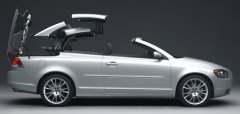 So, the
first thing you notice on the new C70 is the roof. It is quite a
sophisticated piece of mechatronics. Being the world's first
retractable roof for a 4-seater, it splits into 3 pieces - two pieces
for the horizontal roof panel and one for the C-pillars and rear
window. In this way, the roof can be longer than those 2-piece systems
adopted by Peugeot 307CC and Renault Megane CC yet easily fit into a
regular-size trunk. Look at the cramped rear headroom and odd-looking
long tail of the French cars and you will see the benefits of Volvo's
3-piece system. So, the
first thing you notice on the new C70 is the roof. It is quite a
sophisticated piece of mechatronics. Being the world's first
retractable roof for a 4-seater, it splits into 3 pieces - two pieces
for the horizontal roof panel and one for the C-pillars and rear
window. In this way, the roof can be longer than those 2-piece systems
adopted by Peugeot 307CC and Renault Megane CC yet easily fit into a
regular-size trunk. Look at the cramped rear headroom and odd-looking
long tail of the French cars and you will see the benefits of Volvo's
3-piece system.
Press a button, the roof opens and stores into the trunk in about 30
seconds. Now one car serves the two roles previously played by C70
coupe and C70 convertible. No matter in Californian sunshine or Swedish
snow winter, the new C70 is equally enjoyable.
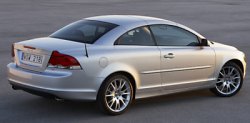 From the
S40-like appearance, you can see the new C70 is built on the S40
platform instead of the mid-size Volvo platform (Theoretically, it
should be renamed to C40, shouldn't it?). Basically, from A-pillars
forward it is almost identical to the S40, although tape measure will
find it got 50mm wider, 110mm longer and 52mm lower. Its windscreen
angle got noticeably faster to deliver a sportier image. Despite of the
open roof, Volvo strengthened its windscreen pillars and side sills to
achieve the same chassis rigidity as the sedan, or doubled from the old
C70 Convertible. But the reinforcement and the sophisticated roof are
by no means lightweight - they brought an extra 200 kg to the kerb
weight. At 1600kg-plus, the C70 is a lot heavier than its compact size
suggested. From the
S40-like appearance, you can see the new C70 is built on the S40
platform instead of the mid-size Volvo platform (Theoretically, it
should be renamed to C40, shouldn't it?). Basically, from A-pillars
forward it is almost identical to the S40, although tape measure will
find it got 50mm wider, 110mm longer and 52mm lower. Its windscreen
angle got noticeably faster to deliver a sportier image. Despite of the
open roof, Volvo strengthened its windscreen pillars and side sills to
achieve the same chassis rigidity as the sedan, or doubled from the old
C70 Convertible. But the reinforcement and the sophisticated roof are
by no means lightweight - they brought an extra 200 kg to the kerb
weight. At 1600kg-plus, the C70 is a lot heavier than its compact size
suggested.
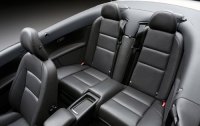 Inside,
the cabin shares exactly the same dashboard and "floating console" with
S40, which is tasteful but probably a little unexciting
for a coupe. The front seats have plenty of space but
the rear legroom
is a little shorter than the old C70, though it is slightly better than
BMW 3-series Cabriolet and Audi A4 Cabriolet. Overall, average size
adults still fit the rear seats with reasonable comfort. Inside,
the cabin shares exactly the same dashboard and "floating console" with
S40, which is tasteful but probably a little unexciting
for a coupe. The front seats have plenty of space but
the rear legroom
is a little shorter than the old C70, though it is slightly better than
BMW 3-series Cabriolet and Audi A4 Cabriolet. Overall, average size
adults still fit the rear seats with reasonable comfort.
Volvo offers four of the S40 engines to the C70: 140hp 2.4 straight-5
10V, 170hp 2.4 straight-5 20V, 220hp 2.5 straight-5 turbo for the T5
model and 180hp 2.4 straight-5 turbo diesel for the D5 model. The heavy
weight means even the flagship T5 is not as quick as we hoped for. It
does 0-60 in 7.2 seconds, about half a second slower than the old C70
T5 and the equivalent S40 T5. Nevertheless, the VVT-equipped
low-pressure turbocharged engine produces a flat torque curve which
matches the relaxed driving manner of C70.
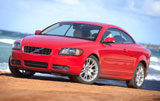 On the
road, the T5 rides comfortably on most surfaces, thanks to a stiff
chassis and civilized suspension setup. The steering is well isolated
from road irregularities, once again promote the relaxed driving
manner. However, the C70 also is rather dull to drive. There is not
much feedback from the steering and from the chassis response. Instead,
there is a mild understeer at the limit and a touch torque steer at
tight corners. While its dynamics is no worse than Audi A4 Cabriolet,
Saab 9-3 Convertible and Mercedes CLK convertible, it does not match
BMW 3-Series convertible. On the
road, the T5 rides comfortably on most surfaces, thanks to a stiff
chassis and civilized suspension setup. The steering is well isolated
from road irregularities, once again promote the relaxed driving
manner. However, the C70 also is rather dull to drive. There is not
much feedback from the steering and from the chassis response. Instead,
there is a mild understeer at the limit and a touch torque steer at
tight corners. While its dynamics is no worse than Audi A4 Cabriolet,
Saab 9-3 Convertible and Mercedes CLK convertible, it does not match
BMW 3-Series convertible.
However, neither cars provide the same level of safety as C70. Like all
other Volvos, the C70 is designed to achieve 5-star Euro NCAP crash
protection rating, thanks to a thin engine which enables a larger than
usual crumple zone. Behind the seats there are two metal hoops which
pop up to protect the passengers from rollover. Besides, it has the
world's first side curtain airbags for an open-top car, which inflate
upwards to protect the passenger's heads in case of lateral collision.
Of course, Volvo's trademark anti-whiplash seats are installed as
standard. It is safety that really mark out the C70 from its
competitors. |